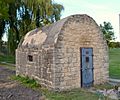One-room jail facts for kids
Imagine a jail with just one room! In the United States, a one-room jail is exactly what it sounds like: a small building used to hold people, with only a single room or cell inside. These tiny jails were common long ago, especially in smaller towns. They were often used for short periods, like when someone was waiting to be moved to a bigger jail.
Contents
Tiny Jails: One Room Wonders
These small jails are interesting pieces of history. They show us how towns used to handle minor problems before bigger police stations and jails were built. Many of these old jails are now protected as historical sites.
Examples of One-Room Jails
- Buhler Jail: This jail is a red brick building found in Buhler, Kansas.
- Clifton Cliff Jail: Built from stone in Clifton, Arizona, this unique jail was actually located at the entrance to a small mine shaft! The mine shaft itself was the cell. Today, it is saved and listed on the National Register of Historic Places.
- Lower Lake Stone Jail: This stone building was built in 1876 in Lower Lake, California. It is one of the smallest historic jail buildings in the United States. It is now a California Historical Landmark.
- San Juan Jail: A wooden building constructed in 1870 in San Juan Bautista, California. It has been fully fixed up and visitors can see it today.
- Washington County Jail: This jail is a one-room log cabin in Hillsboro, Oregon. It was built in 1853 and used until 1870. It is now preserved and was added to the National Register of Historic Places in 1986.
Calaboose: A Special Name for Small Jails
In some parts of the United States, a small, separate jail building with one or two rooms is called a calaboose. This word comes from Spanish and means "dungeon." Calabooses were mostly used to hold people for small rule-breaking, like causing a disturbance in public. They also served as a temporary place to keep someone before they were taken to a larger county jail.
Calabooses were very common across the United States in the 1800s and early 1900s. You can still find many examples of them today. Texas has the most historic calaboose buildings, with over 100 known structures. Many calabooses have only one cell and often have a curved or rounded ceiling. They were usually made of solid concrete, but some were built from brick, stone, or wood.
Examples of Calabooses
- Arrow Rock Calaboose: This stone building with a rounded ceiling is in Arrow Rock, Missouri. It was built in 1873 after the first wooden jail was burned down. The city of Arrow Rock has fully restored it, and it is open to visitors.
- Bronwood Calaboose: A wooden building with a pointed roof and two cells. It was built around 1900 in Bronwood, Georgia, and was used until 1954. It was added to the National Register of Historic Places in 1982.
- Delmar Calaboose: Located in Delmar, Iowa, this calaboose was built from limestone blocks in 1878. It was used for many years into the 1900s. It is currently listed on the National Register of Historic Places.
- Elsberry Calaboose: This limestone block building was constructed around 1896 to replace an earlier wooden calaboose that burned. Found in Elsberry, Missouri, the city has fully restored it, and it is open to the public.
- Holliday Calaboose: A concrete building with two cells in Holliday, Texas. It was built in the 1920s and is now privately owned. You can find it in an empty lot near the Holliday Post Office.
- Ruby Jail: This small concrete building with a rounded ceiling is in the old mining town of Ruby, Arizona. It was built in 1936 to replace an unusual "jail tree." It has been listed on the National Register of Historic Places since 1975.
- Texola Jail: Made of concrete and cinder blocks, this jail is in Texola, Oklahoma. It was built in 1908 and used until 1910. It is now open for people to see.
- Wingate Calaboose: A red brick building constructed in 1897 and used until 1945. It is located behind the town hall in Wingate, Indiana.
Strap-Iron Jails: Cages in the Open Air
A strap-iron jail is a type of outdoor jail made from strong metal bars, like a large metal cage. These jails usually had one or two cells. Strap-iron jails were commonly used in the United States in the mid to late 1800s. Several examples of these unique jails still exist in Texas.
Examples of Strap-Iron Jails
- Berne Jail: This jail was originally inside the 1895 Berne Fire Station in Berne, Indiana. Now, you can see it on display at the Swiss Heritage Village in Berne.
- Clarksdale Jail: This strap-iron jail is located in Clarksdale, Mississippi.
- Foss Jail: An old town jail located just off Route 66 in Foss, Oklahoma.
- Helena Jail: This jail is located and on display in the old mining town of Helena, Texas. Another strap-iron jail from Falls City, Texas is also in Helena.
- Kelso Depot Jail: A strap-iron jail with two cells that was used to hold people in the old mining town of Kelso, California, in the 1940s. It is now on display at the Kelso Depot.
- Mobeetie Strap-Iron Jail: This jail is located and on display in Mobeetie, Texas. It is different from the historic 1886 jail building there.
- The Calaboose: This jail is owned by the Punta Gorda Historical Society in Punta Gorda, Florida. It was originally on Olympia Avenue but has been restored and is now on display at History Park in Punta Gorda.
Images for kids







